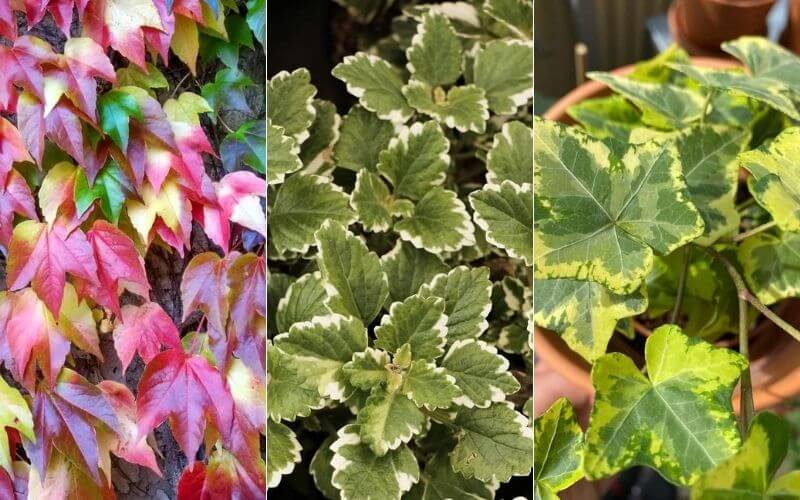
Creeping on trees and walls, or crawling in shady ground, ivy is associated with ruins, architecture, old buildings, follies and historical gardens.
In fact, if you want your garden to look “well established” no plant is better than ivy at that.
Also great at covering walls, softening corners and edges of masonry or concrete, ivy says, “overgrown forest” wherever you plant it.
There are, however, many types of ivy (or Hedera with its scientific name): English ivy is the most common, with a few varieties within this species, but then you also have Irish ivy, Persian ivy, Russian ivy, Japanese ivy, Nepalese ivy, Canarian ivy, Algerian ivy and two “faux ivies” to choose from: Boston ivy and Swedish ivy.
Not sure yet which one to choose? Look at the pictures in this article with an open heart, and then use your brain to pick the best one for you reading the descriptions, best gardening points and growing needs and tips for each type…
How to Identify Ivy Types
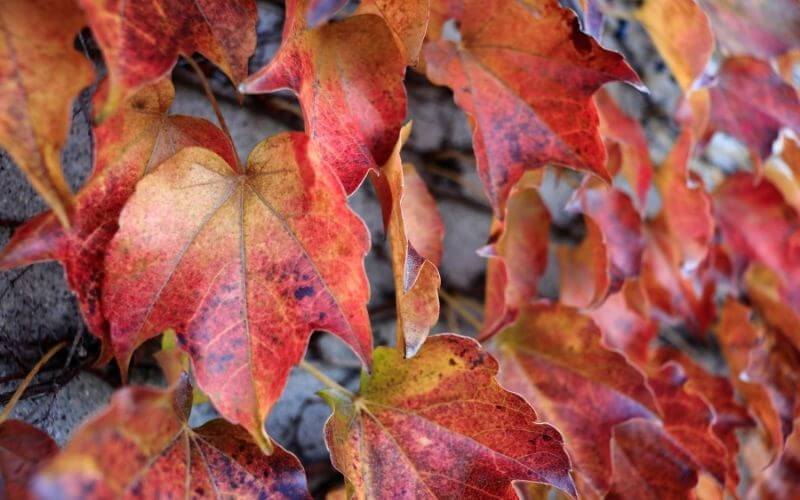
Naturally, the pictures in this article will help you identify the different types of ivy; on top of being beautiful, that is!
While there are many differences between the different species and varieties, the first and foremost way to identify which species, cultivar etc. of ivy you are looking at is the leaf, its shape, color(s) and overall appearance.
However, when deciding which variety you want, you will also want to know ho tall it will grow, and how thick the foliage is.
For example English or Canarian ivies are far thicker than Russian ivy, and if you want to completely cover a wall, you’d better choose one of the first two varieties…
Ivy And Soil
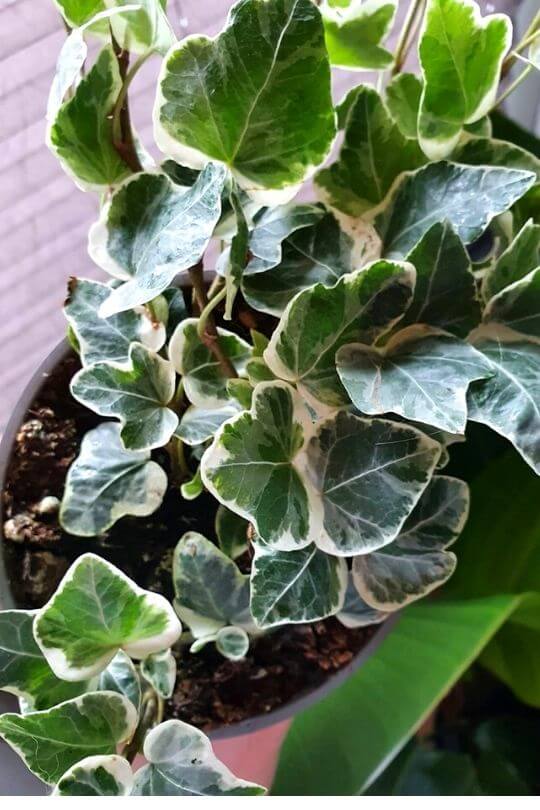
Ivy is a bit strange, isn’t it?
Look at a big, even self supporting ivy plant and find its roots… look carefully and you will find no roots at the base of the plant!
But it’s not true that it does not have them… it has aerial roots, just hidden under the leaves along the stem to the plant…
So, how about the soil? What is the right soil for ivy? With ivy you will have little problems, because while a boggy or waterlogged soil will result in disease (rot, infestations etc.), ivy is not fussy about the rest.
Clay, chalk, loam or sandy soil are fine, with pH from alkaline to acidic (but preferably near neutral) and well drained. That’s all it needs.
15 Different Types Of Ivy Plants With Pictures
As you can see, ivy is a very “cosmopolitan” plant, but wait till you meet all these varieties “in person”…
So, without further ado, here are 15 of the best types of ivy grouped as English ivy, with many varieties, other real ivy varieties and faux ivies you can choose from!
English Ivy Varieties
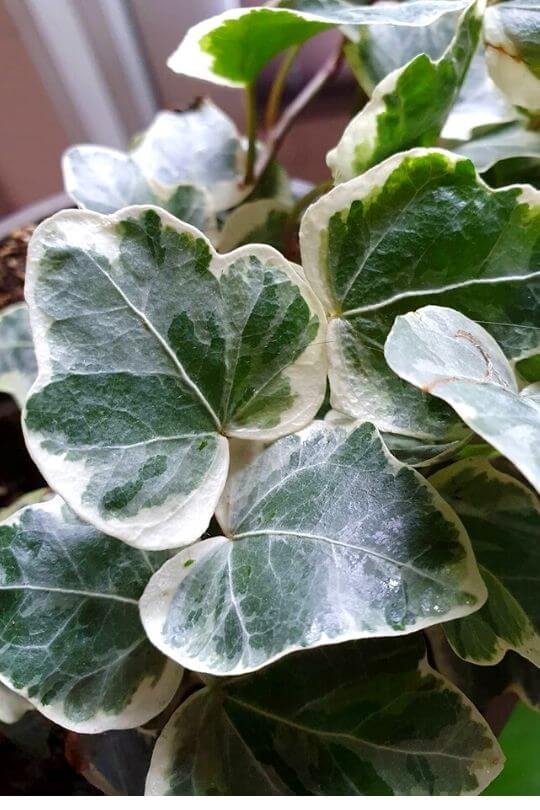
English ivy is the largest group of ivies we have; its scientific name is Hedera helix, and it is native of Europe.
It has been used in gardening for centuries, which means that there are now cultivars and varieties aplenty on top of three subspecies.
The leaf of English ivy has the typical five lobes of this evergreen creeper and climber, making it a very classical choice for your garden.
1. ‘Anne Marie’ English Ivy (Hedera helix ‘Anne Marie’)
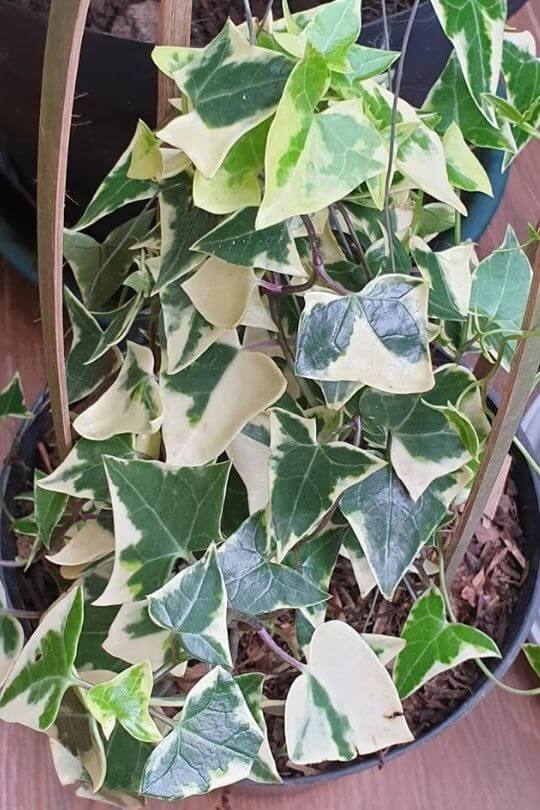
‘Anne Marie’ English ivy is a soft and classical looking variety, with shallow gaps between the lobes, which gives them a very “smooth” and “appeasing” appearance.
The leaves of ‘Anne Marie’ have delicate veins, and their color is usually forest to hunter green in the middle, bit the edges are cream.
However, you may have variations according to light exposure, as they may turn light green in the Sunlight.
This is a beautiful variety of ivy which is perfect for a traditional, Old World, but also romantic look; the foliage will be quite thick but the cream colored edges will add a sense of movement and texture to it which you won’t regret, and which also makes it suitable for urban gardens.
2. ‘Needlepoint’ English Ivy (Hedera helix ‘Needlepoint’)
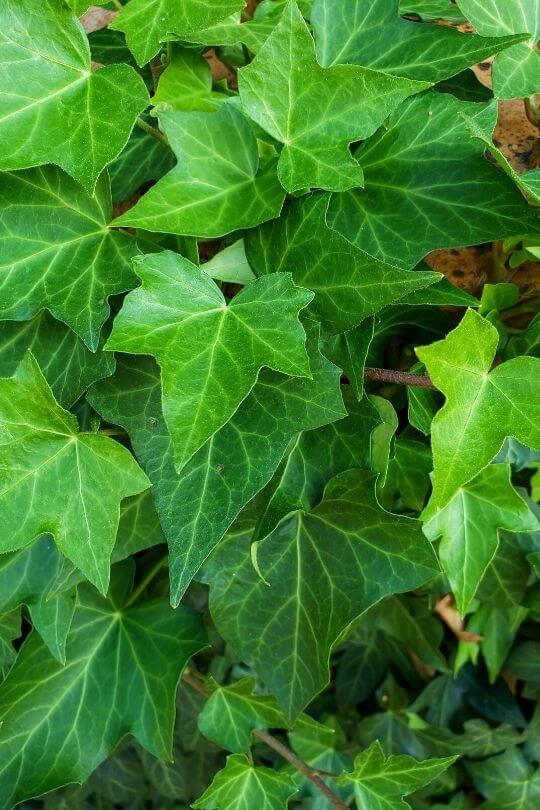
For a bolder look, ‘Needlepoint’ offers you very well divided and pointed lobes, bringing the classical ivy leaf shape to its extremes.
If it is the shape of the leaf that you want to highlight in your garden, then this is arguably the best variety to have.
The leaves themselves are dark emerald to jade green, so, a sweet and warm shade of this color, and they are glossy, with lighter veins; they grow at regular intervals on the vines, but the overall effect is one of almost complete foliage cover.
This is an ideal variety of ivy to turn that boring wall or fence of yours into an interesting pattern of green and “five-fingered waving hands”, and it will also look great growing on the steps that lead to your front door, greeting your guests as they arrive…
3. ‘Goldchild’ English Ivy (Hedera helix ‘Goldchild’)
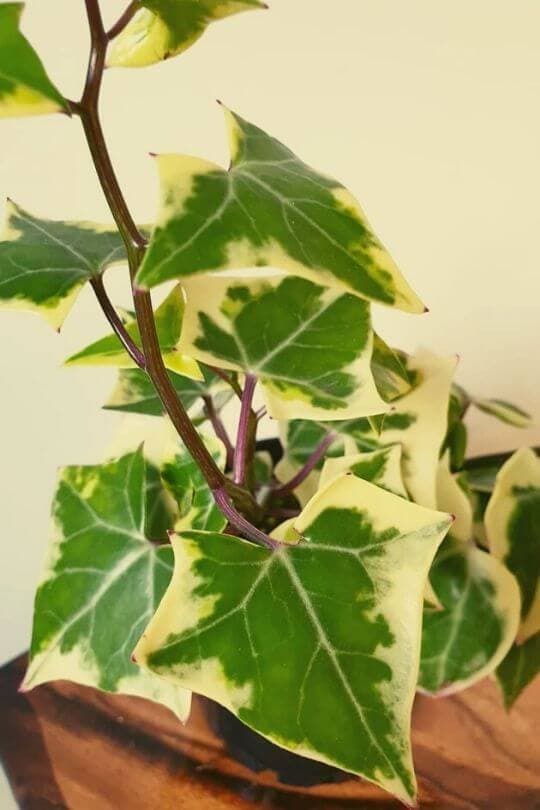
‘Goldchild’ has a softer leaf shape than ‘Needlepoint’ bit still the five pointed outline is very clear and neat, also thanks to the banana yellow edges, a nice but harmonic contrast with the green leaves which start off as light and turn hunter green later on.
Paler, pretty straight veins then add a silver green finishing touch to the beauty of the leaves of this English ivy.
This variety too has dense and covering foliage, and, thanks to its mellow and comforting appearance, it will be perfect if you want that established look in your garden that also brings a sense of security and peace.
A very hardy and easy to grow and adaptable variety, it is a recipient of the Award of Garden Merit of the Royal Horticultural Society and it even won the Ivy of the Year Award in 2008.
4. ‘Ivalance’ English Ivy (Hedera helix ‘Ivalance’)

If a beautifully shaped and colored flat leaf is not enough for your garden, then ‘Ivalance’ English ivy offers you the alternative of wavy leaf edges, which look a bit like they are curling onto themselves.
Winner of the Ivy of the Year Award by the American Ivy Society in 2011, this is a variety that you will enjoy if you want a classical look bit with a touch of originality.
The beauty of this plant is that close by, the leaves will draw you in with their rebellious look, and the wild appearance of this English ivy is then underscored by very glossy leaves indeed.
They are dark rich green with lighter light at the top, and light but bright green at the bottom.
But this unusual variety also has a very intriguing effect from afar; it too has very thick foliage that will completely cover your wall or fence, but the texture you will get will be very complex, decorative and rich…
This is basically the Baroque version of English ivy, to give you an architectural comparison…
5. ‘Tripod’ English Ivy (Hedera helix ‘Tripod’)
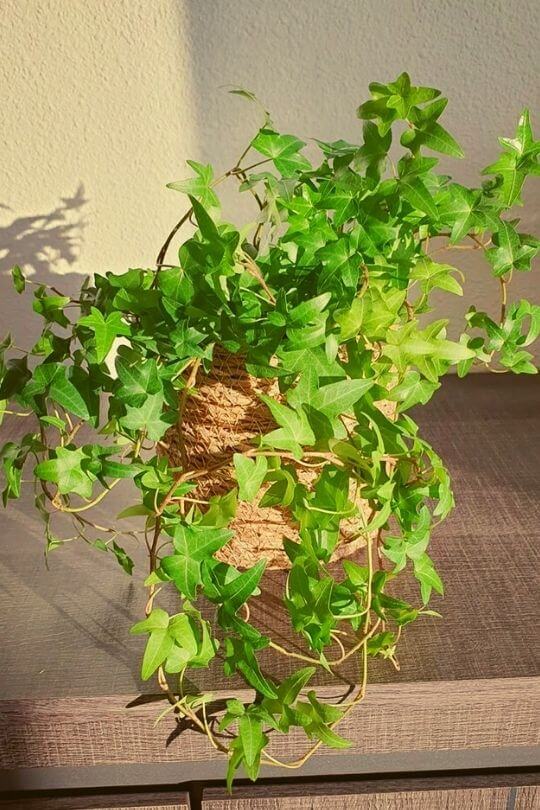
Another unusual variety is ‘Tripod’ English ivy, so called because its leaves have three, long, slender and pointed lobes, rather than five.
They are of a glossy texture and deep and rich green color, divided fairly regularly by lighter green veins, and it is sometimes called arrowhead ivy.
The foliage of this variety is thick as well, but the overall effect differs from the ones we have seen so far… In fact, thanks to the unusual shape of its leaves.
This English ivy is very suitable for tropical or Mediterranean gardens, where the many lush leaves will remind your visitors of a shady spot in an exotic place, hidden under the canopy of a green and wild rain forest.
Be careful though, the sap of ‘Tripod’ English ivy is an irritant, the leaves and the fruit are poisonous.
6. ‘Golden Curl’ English Ivy (Hedera helix ‘Golden Curl’)
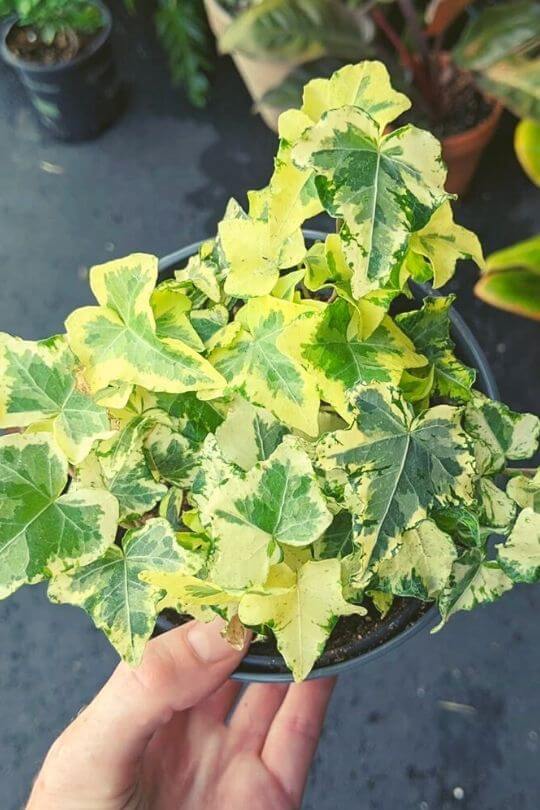
One of the most vibrant and energetic varieties of English ivy you can find is ‘English Curl’.
Its leaves, as the name suggests, are curly at the edges, but the shape may vary a bot, from almost pentagonal to more clearly defined lobes (but never very long).
However, what makes this variety stand out is the color of its foliage: it is of a vibrant blonde, almost lemon yellow for most of the leaf, with beautiful rich and often dark green patches towards the edges of the leaf.
You can imagine the life and light infusing effect that this pretty large English ivy, with fairly thick, bright yellow and wavy foliage can have on a wall…
Make sure you make the best of this variety’s eye catching color, maybe choosing a fence at the end of a long perspective line.
Note too, however, that all parts of this plant are poisonous if you ingest them.
Other Real Ivy Varieties
These are all different species or real ivy (Hedera), but we have grouped them together because they don’t have as many cultivars as English ivy, and you will not find as many varieties of these on the market.
Still, they are all very beautiful, as you are going to find out…
7. Irish Ivy (Hedera hibernica)
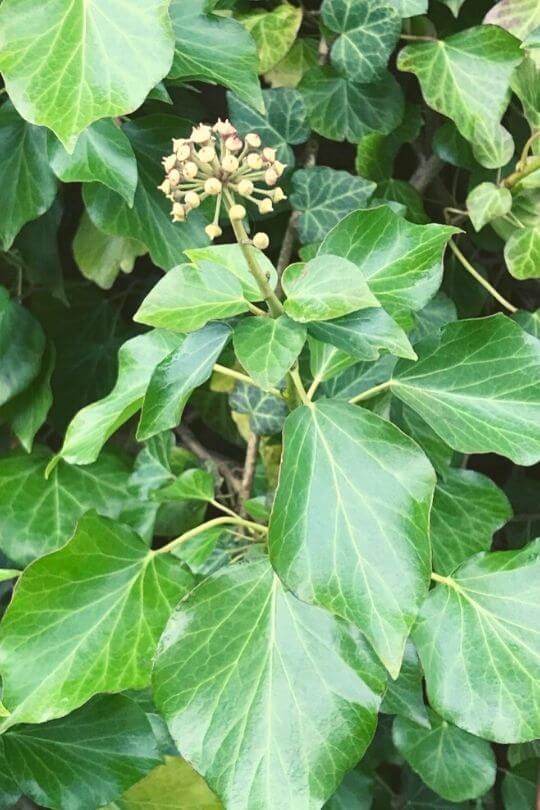
A variety of Ivy that comes from the Atlantic countries of Europe, Irish Ivy has a simple and heart warming beauty.
The leaves of Irish ivy are of a glossy emerald green color, soft in shape, with lobes that, for lack of a better word, could be defined as “artistic and with fluid contour lines”.
This makes it also “modern”, meaning that it looks like a stylized ivy leaf, but on the whole, its appearance is very traditional and classical.
This is a perfect plant if you are after a vibrant carpet of green to cover walls or fences – even big ones, as this is a giant of the Hedera genus and it can grow to be 10 storeys tall!
While it will suit modern gardens thanks to its leaf shape, it is also perfectly suited to traditional ones, as the overall appearance is that of a well known green presence from our common past.
8. Persian Ivy (Hedera colchica)
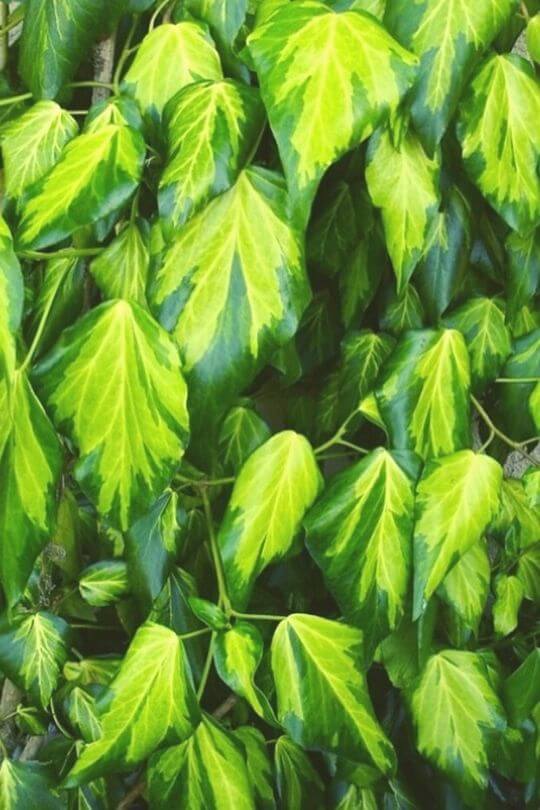
A very lush and soft variety of ivy, with large, glossy leaves that partly curl backward, making them look like drapery hanging on the branches, Persian ivy has a look of gentle abundance that can make any wall or fence look like a corner of paradise.
The leaves are big, up to about 10 inches in length (25 cm), which give it a very exotic look, and they are more heart shaped than five lobed in most varieties.
However, Hedera colchica ‘Dentata’ has clear, pointed lobes, but if you want large drops of yellow in dark green frames, choose Hedera colchica ‘Sulphur heart’, whose leaves have a central part that starts off light green and then turns yellow.
It is also an excellent plant for groundcover, especially if you have a large patch of unused land that you want to turn into a thick and lush green carpet.
9. Russian Ivy (Hedera pastuchovii)
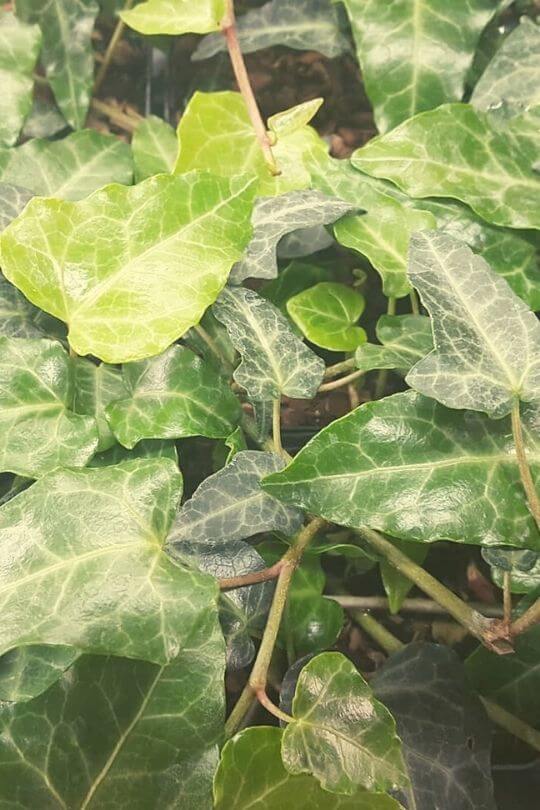
For yet a different effect, Russian ivy has lanceolate green leaves that grow in opposing pairs and on bright red petioles.
The leaves the,selves are regularly arranged, at times on arching branches, an unusual habit for ivy, that end in a little cluster of black berries.
While the main species has leaves within the Golden Ratio proportion and fairly uniform in color (Kelly green), Hedera pastuchovii ‘Ann Ala’, a very popular cultivar, has long and dropping leaves with dark green to even purple outer coloring and bright green veins and center.
‘Ann Ala’ Russian ivy has won the Award of Garden merit of the Royal Horticultural Society.
Note that all parts of this plant are poisonous of you ingest them.
10. Japanese Ivy (Hedera rhombea)
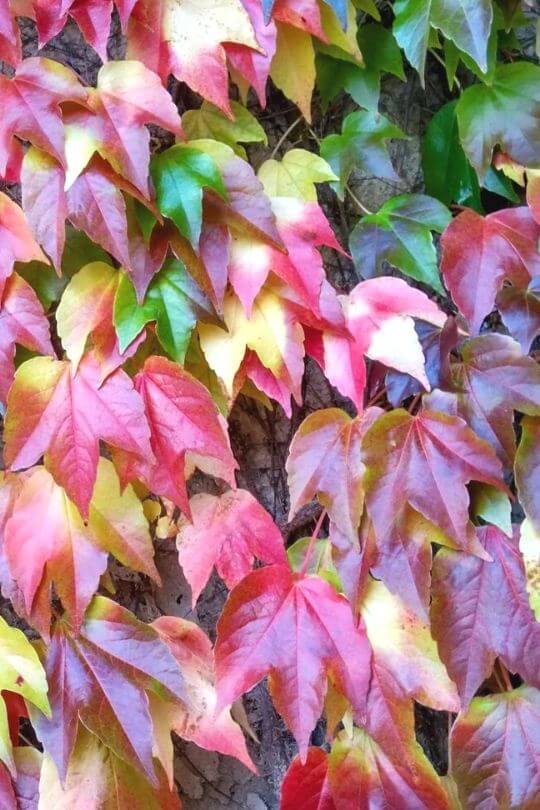
Who knows why everything that comes from East Asia is always so elegant? Japanese ivy is no exception; growing naturally on tree trunks and rocky slopes in laurel forests.
This ivy species has glossy leaves of varied shape, according to the variety, and clusters of showy purple black berries at the end of branches, that sometimes have an upright habit.
In fact, Japanese ivy is so elegant that it looks like a houseplant.
The foliage is less dense than in other varieties, but this only serves to allow the single leaves to stand out more clearly against brickwork or wood fencing.
With cultivars like ‘Crème de Menthe’, that has dark green leaves with dashes of cream by the edges, Japanese ivy offers you a light and elegant option to soften those hard corners in your garden.
11. Nepalese Ivy (Hedera nepalensis)
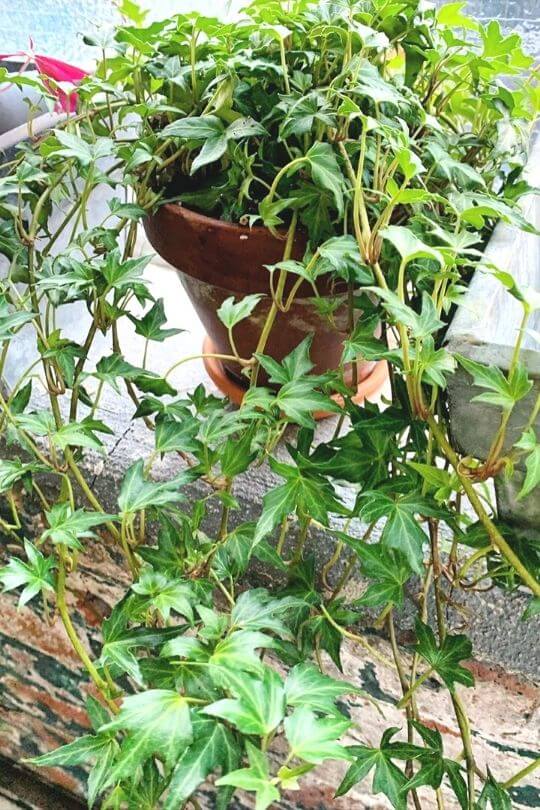
Also called Himalayan ivy, Nepalese ivy is an Asian species you will appreciate for its very rich, dark and glossy leaves with clear, decorative and light green veins, that make each leaf a true work of art.
On the whole, the foliage is less thick than English ivy, giving you a more dappled effect when covering ground or surfaces with it.
Thanks to this quality, it will also loom great growing on rocks, while leaving part of them in sight as well, which makes it the ideal variety to climb on statues and fountains…
12. Canarian Ivy (Hedera canariensis)
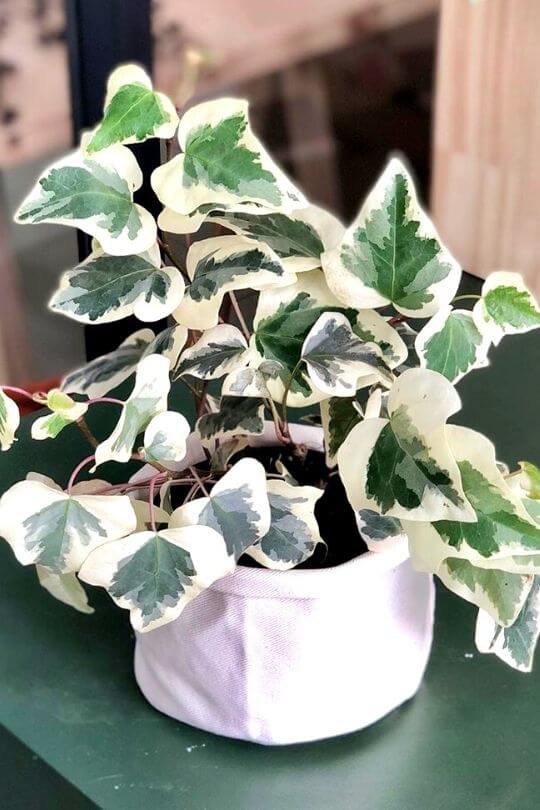
Canarian ivy may look very similar to English ivy, with an overall effect that can honestly be compared.
In fact, it has dense foliage of a deep green shade, which immediately gives and idea of visiting a temperate forest when pacing along your garden, and may make your guests expect a folly partly hidden by the lush vegetation of this plant…
But there are so e key differences; the lobes are only sketched and the contour of the leaf turns into a wavy line; at the same time, it also grows faster and establishes itself quicker than English ivy.
So, Canarian ivy may be the one to do the job for you if you want to have that “old garden look” but you have no time to wait for it.
If you want an extra thrill, the ‘Variegata’ cultivar has leaves of two colors, green and cream.
13. Algerian Ivy ‘Gloire de Marengo’ (Hedera algeriensis ‘Gloire de Marengo’)
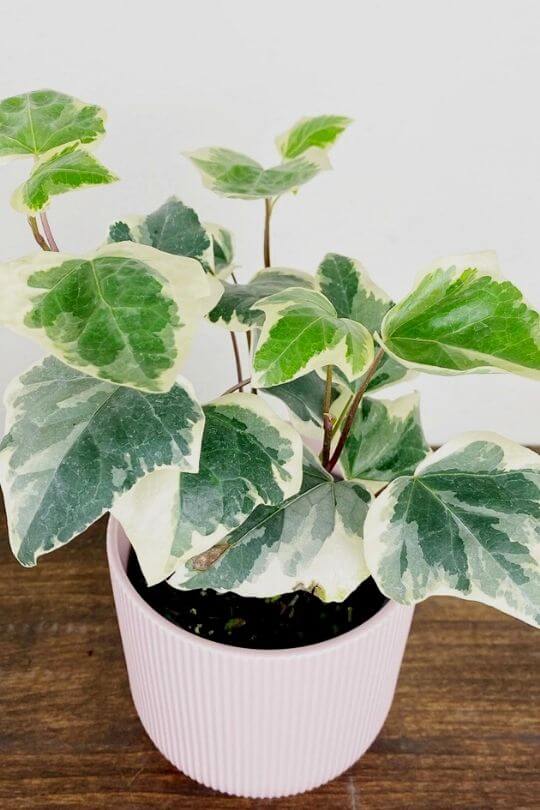
The beautiful, heart shaped to roughly triangular dark Sacramento green leaves with cream margins that hang on purple branched and petioles of Algerian ivy ‘Gloire de Marengo’, their large size (4 to 5 inches, or 10 to 12 cm) make it an ideal choice for a garden that wants to look established but also classy and eye catching.
The Sacramento shade in particular make suitable for a grand and even noble setting, and, as long as you keep this beauty.
Winner of the Award of Garden Merit of the Royal Horticultural Society, sheltered from cold winds, it will even resist drought will still bringing a dramatic but elegant effect to your arbors and pergolas.
FAUX IVY VARIETIES
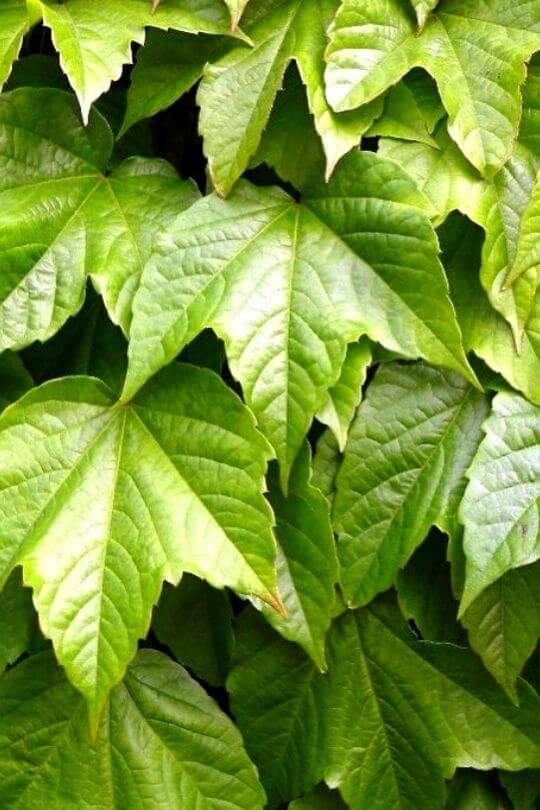
Here are two plants that are not scientifically ivy, as they do not belong to the Hedera genus, but they look like ivy, and you will find them sold as such in many garden centers; for convenience’ sake, let’s call them “faux ivies”.
14. Boston Ivy (Parthenocissus Tricuspidata)
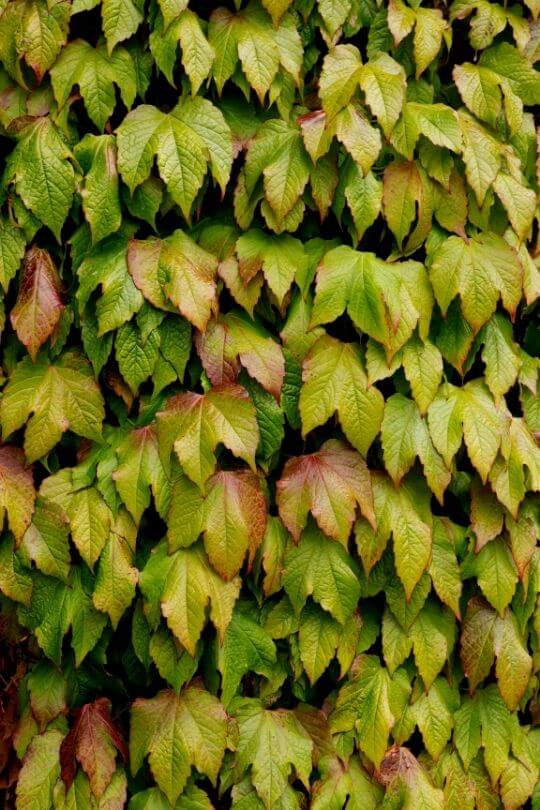
You would be totally forgiven if, on seeing a wall covered in Boston ivy, you thought it was real ivy, even English ivy.
In fact, it is very similar, with very glossy medium dark emerald green leaves with three pointed lobes and serrate margins.
But then you will notice that these beautiful leaves come at the end of long individual green and almost upright stalks, which makes the whole foliage look like suspended in the air, a bit like some strange and light origami installation in a museum of modern art.
And, unlike real ivy, Boston ivy is deciduous, so, it will not cover your fence, wall or unsightly shed in winter.
However, when it does cover it, it will do it with great elegance and with sparser foliage than English ivy, leaving the wall in sight behind the beautiful leaves.
In fall, though, because it is not evergreen, the leaves will turn yellow and red, giving you a display of color that can set your whole garden on fire (metaphorically speaking, of course)!
Because of its elegant appearance and orderly habit, it is a better choice than most real ivy varieties for sunny spots in modern gardens, including urban gardens.
15. Swedish Ivy (Plectranthus Australis)
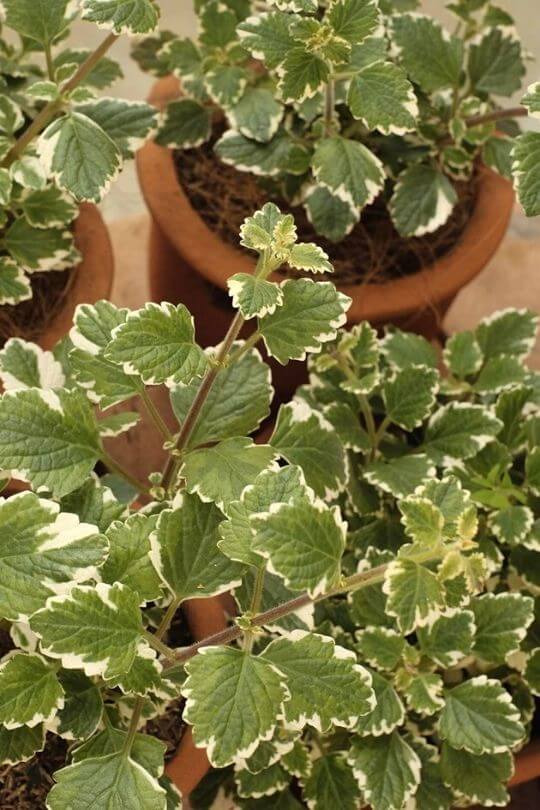
Swedish ivy is an herbaceous evergreen perennial gardeners love for its cascading branches with hear shed serrated leaves, which can be light, jade green or darker Barbour green with cream edges with the variegata variety.
It will also produce white or purple, long and tubular flowers, which make it ideal as a smaller “ivy like” plant to grow in decorative, maybe even sculptural pots on terraces, patios, or on the side of the steps that lead to your home.
Ivy: a Journey though Time and Space…
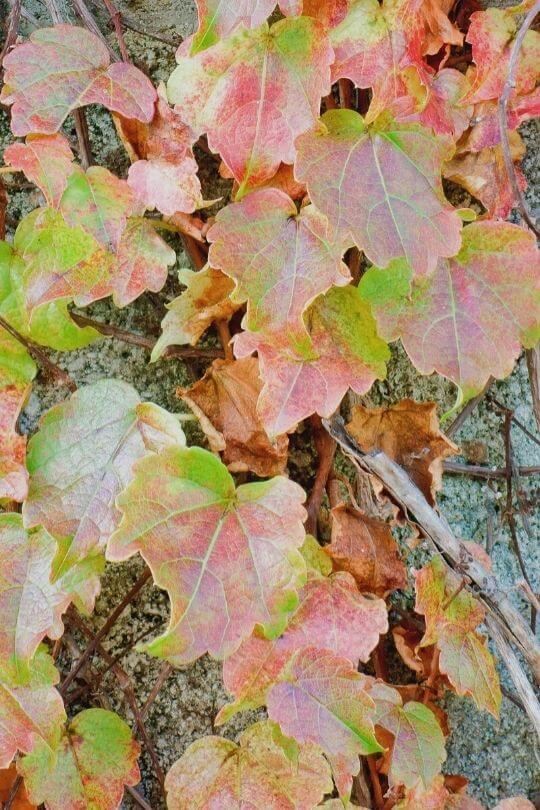
Ivy can make your garden look like it’s always been there even if it is only a few years old; this is arguably the “magic” of this plant, that touch, that gardener’s trick that can make all the difference. Plant some ivy and it will be like traveling back in time in a matter of months…
And in space too! Yes, because as you can see, ivy is English, Nepalese, Japanese, Algerian… Ivy is a plant that can bring the whole world into your garden!

Written By
Amber Noyes
Amber Noyes was born and raised in a suburban California town, San Mateo. She holds a master’s degree in horticulture from the University of California as well as a BS in Biology from the University of San Francisco. With experience working on an organic farm, water conservation research, farmers’ markets, and plant nursery, she understands what makes plants thrive and how we can better understand the connection between microclimate and plant health. When she’s not on the land, Amber loves informing people of new ideas/things related to gardening, especially organic gardening, houseplants, and growing plants in a small space.

hELLO JUST ask if you know the name the house lantg its very very similar to
Swedish Ivy (Plectranthus Australis) the variety Im looking its more circular. unforchanily Im dont have bopicture of them, some ne come to clean my homw and when I come in back just ask and she say its broke and trade away, I look evry where and I didnt found yet BECAUSE I DIDNT KNOW THE REAL NAME, just llok and ask.
Based on your description, it’s possible that the plant you are referring to is Plectranthus verticillatus, commonly known as “Swedish Begonia” or “Creeping Charlie.” It has round leaves similar to Swedish Ivy (Plectranthus australis), but with a more compact growth habit. Another possibility is Plectranthus oertendahlii, also known as “Vick’s Plant,” which has circular, succulent-like leaves with a distinctive menthol fragrance. Without a picture, it’s difficult to identify the exact plant you are looking for, but I hope this information is helpful.